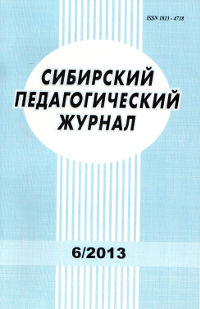The Model of Cognitive Activity of high School Students with Material Sources in History Lessons
1. Aleksashkina, L. N., ed., 2025. Historical education of schoolchildren in modern Russia: current issues of theory and practices. Novosibirsk: NSPU Publ., 255 p. (In Russ.)
2. Aleksashkina, L. N., 1999. Methodological foundations of the school history course. Dissertation Doct. Sci. (Pedagogy). Moscow, 330 p. (In Russ.)
3. Khlytina, O. M., 2014. Postcards of the Soviet era in the research and project activities of schoolchildren. Visual images of the past: new strategies for use in educational and research practice. Novosibirsk: NSPU Publ., pp. 41–55. (In Russ.)
4. Sidorchuk, O. N., 2014. Studying the history of Russia in the 19th–20th centuries based on candy wrappers. School technologies, no. 5, pp. 70–90. (In Russ.)
5. Volgin, O. A., 2021. Developing skills in working with documentary photographs and video materials in history education. Teaching history at school, no. 3, pp. 49–53. (In Russ.)
6. Bekhtenova, E. F., 2023. Soviet porcelain as a historical source in history lessons during the study of the topic «Arctic exploration in the 1930s». Historical past in humanities research and educational practice. Proc. Inter. Interconf. Novosibirsk: NSPU Publ., pp. 10–25. (In Russ.)
7. Khlytina, O. M., Leybova, E. K., 2013. Oral historical sources in educational historical knowledge at the senior level of school. Teaching history and social studies at school, no. 1, pp. 17–25. (In Russ.)
8. Alekseev, V. V., 2020. Theoretical and methodological foundations of the study of material sources. The role of material sources in the information support of historical science. Moscow: INION RAS Publ., pp. 21–34. (In Russ.)
9. Khlytina, O. M., 2011. Historical sources in educational historical knowledge: experience and prospects. Historical sources in research and educational practice. Novosibirsk: NSPU Publ., pp. 81–102. (In Russ.)
10. Khlytina, O. M., 2023. Mini-research projects in history lessons: where to start and how to engage schoolchildren. The 10th international Siberian historical forum «Siberia and Russia: history and culture». Moscow: Pero Publ., pp. 1279–1284. (In Russ.)
11. Abdulaeva, N. A., 2011. The use of material and visual sources in history lessons. Teaching history and social studies at school, no. 3, pp. 57–59. (In Russ.)
12. Zvereva, K. E., ed., 2012. Exhibits of local history museums as the foundation of historical and cognitive activity of schoolchildren. Teaching history and social studies at school, no. 6, pp. 20–30. (In Russ.)
13. Korotkova, M. V., 2003. Costume in history lesson. Teaching history and social studies at school, no. 3, pp. 20–25. (In Russ.)
14. Larochkin, A. A., 2024. Soviet coins and banknotes as a historical source in the study of Russian history at school. Teaching history and social studies at school, no. 8, pp. 28–36. (In Russ.)
15. Leybova, E. K., 2012. Clothes as source of studying of history of daily occurrence of the XX century. Teaching history and social studies at school, no. 9, pp. 61–66. (In Russ.)
16. Sokolova, M. V., 2006. Work with material sources in history lessons. Teaching history and social studies at school, no. 6, pp. 19–24. (In Russ.)
17. Khlytina, O. M., 2011. Material sources in school history lessons. Historical sources in research and educational practice. Novosibirsk: NSPU Publ., pp. 212–221. (In Russ.)
18. Korotkova, M. V., 2021. The methodology of using material sources in teaching history and museum educational practice. School of the future, no. 1, pp. 38–43. (In Russ.)
19. Choref, M. M., 2015. The use of numismatics and bonistics in history lessons in schools in the Urals and Siberia. Nizhniy Novgorod education, no. 2, pp. 62–66. (In Russ.)
20. Pervushkin, T. V., 2021. The methodology of using numismatic sources in history lessons. Lebedev readings. Penza: PSU Publ., pp. 448–452. (In Russ.)
21. Pokrovskiy, G. A., ed., 2024. The use of numismatic material in history lessons. Science in a Megapolis, no. 7(63). (In Russ.)
22. Apostolova, T. M., ed., 2022. It all starts with historical sources. Moscow: Knigodel Publ., 92 p. (In Russ.)
23. Vygotskiy, L. S., 1935. Mental development of children in the learning process. Moscow; Leningrad: State educational and pedagogical Publ., 133 p. (In Russ.)
24. Galperin, P. Ya., 1998. Psychology and mind and the theory of step-by-step formation of mental actions. Psychology as an objective science. Moscow: IPPSY Publ., pp. 272–318. (In Russ.)
25. Leontiev, A. N., 1960. About the formation of skills. Questions of psychology, no. 1, pp. 7–18. (In Russ.)
26. Shchedrovitskiy, G. P., 1995. Selected works. Moscow: School of Cultural Policy Publ., 800 p. (In Russ.)
27. Elkonin, D. B., 1989. Selected psychological works. Moscow: Pedagogy Publ., 560 p.
28. Barabanov, V. V., Lazukova, N. N., 2013. Methodology of teaching history: textbook. Moscow: Academia Publ. Center, 430 p. (In Russ.)
29. Osmolovskaya, I. M., 2020. Didactics: from classics to modernity. St. Petersburg: Nestor-History Publ., 248 p. (In Russ.)
30. Larochkin, A. A., 2024. Things in Russian history lessons in 11th grade: selection of sources. Youth of the 21st century: education, science, innovation. Proc. Stud. Conf. with Inter. Part. Novosibirsk: NSPU Publ., pp. 325–327. (In Russ.)




